The Species of Origins, Part 2
Welcome to Magic Origins Preview Week 2. Last week I began telling you the story of the design of Magic Origins. I left things in a bit of a cliffhanger, so I figure I'll pick up where I left off and finish the story. (If you haven't read last week's column , I strongly urge you do so as I'm assuming you have.) I also have another cool preview card to show you. Hopefully that entices you to jump to the next paragraph.
"And Now For Something Completely Different"
When the last column ended, the Magic Origins design team found out that due to some major shake-ups in Magic (see this article if you have no idea what I'm talking about) they were going to have to scrap their current design and start all over. Also, the scope of the project had gotten bigger even though they only had half the time to design it. Here's what was on their plate:
- Figure out the ten two-color archetypes and match them to the ten worlds in the set
- Design five transforming Planeswalkers
- Create two brand new mechanics
- Create a mechanical framework to allow the creative to tell five different stories
- Find appropriate reprints
- Make a fun core set
Let's walk through these tasks and see how they accomplished each of them.
Figure out the ten two-color archetypes and match them to the ten worlds in the set
Shawn Main (the lead designer of Magic Origins) and his team structured the set to create five parallel Planeswalker stories. In each one, we would start on the Planeswalker's home world, learn about their life, watch their spark ignite, and see them planeswalk for the first time. Then we follow them on their adventure on the plane of their first visit. This meant the set would have ten planes (five home planes and five first visits). The set needed ten two-color Draft archetypes, so Shawn and his team had the bright idea of lining them up. This proved to be a bit complicated.
There are obviously ten two-color pairs:
White-Blue
White-Black
Blue-Black
Blue-Red
Black-Red
Black-Green
Red-Green
Red-White
Green-White
Green-Blue
Each one had to be tied to one of the ten planes in the set. The first thing Shawn had to do was to consult with the story team to figure out what exactly those ten planes were. Let's start with the home planes. Nissa was from Zendikar. She was there in the original Zendikar block and it was firmly established that Zendikar was her home. It was known that Liliana was from Dominaria, although this knowledge didn't seem to be widely known by the public (who were very excited, by the way, when they learned Liliana was from Dominaria after Jenna revealed the fact a few weeks ago). The home plane of the other three were not publicly known.
The story team knew that Gideon was from Theros. (There were a few small teases about this such as the flavor text for the card Desperate Stand from Journey Into Nyx.) They knew Chandra was from a world that we had never seen before. Based on her outfit, it was a world with some aspect of a steam punk feel. I'm not sure when Jace's home world was decided upon as Vryn. It might go all the way back to Planechase, where the card Trail of the Mage-Rings first appeared, the only card before Origins that showed Vryn. Jace's missing information about his own home world made it something that no one publicly had any clue about.
Next was figuring out what the first world they planeswalked to was. I believe Gideon's first planeswalk to Bant (aka a shard of Alara) had been heavily hinted at. Likewise, Chandra had been connected to the fiery plane of Regatha in the novel Purifying Fire. For the other three characters it was a matter of figuring out what led to the best story. Jace's strong tie to Ravnica made it a perfect first planeswalk for Jace, as did Liliana's thematic connection with Innistrad. Nissa's story required her interacting with a different kind of elf so, after a little searching, it was decided that Lorwyn was the perfect fit.
This meant that we now had our ten planes:
| Planeswalker | Home Plane | First-Planeswalk Plane | |
|---|---|---|---|
Gideon | Theros | Bant | |
Jace | Vryn | Ravnica | |
Liliana | Dominaria | Innistrad | |
Chandra | Kaladesh | Regatha | |
Nissa | Zendikar | Lorwyn |
Now the trick was to line the two up. The first obvious decision was that as we were following five characters that were each monocolor that both their home plane and their first visit had to have their color in it.
Theros: White-???
Bant: White-???
Vryn: Blue-???
Ravnica: Blue-???
Dominaria: Black-???
Innistrad: Black-???
Kaladesh: Red-???
Regatha: Red-???
Zendikar: Green-???
Lorwyn: Green-???
As the design team looked over the stories, a few things became clear. Gideon was connected to the city of Akros, which was red-white, so that color combination made sense. Liliana started as a healer on Dominaria and eventually ended up a necromancer in Innistrad. That pushed for Dominaria to be white-black and Innistrad to be blue-black as those are the color of the Zombies on Innistrad. Chandra's home world wanted a steam punk feel so going blue-red made a lot of sense. Nissa's visit to Lorwyn had her interacting with the Elves of Lorwyn, who were black-green. When we plugged those in, they got:
Theros: Red-White
Bant: White-???
Vryn: Blue-???
Ravnica: Blue-???
Dominaria: White-Black
Innistrad: Blue-Black
Kaladesh: Blue-Red
Regatha: Red-???
Zendikar: Green-???
Lorwyn: Black-Green
As the chart started filling in, it started dictating some choices. For example, Jace's two planes had to both be blue but blue-black had been taken by Innistrad and blue-red by Kaladesh. After consulting with the story team, it was decided that Vryn was more white-blue and that Ravnica being the home of all ten two-color pairs allowed it to have any combination. Bant then ended up having to be green-white because Vrynn had white-blue, Dominaria white-black, and Theros had white-red. This meant that Zendikar needed to be red-green as green-white was Bant, green-blue was Ravnica, and black-green was Lorwyn. Finally, that meant Regatha had to be black-red because white-black was Dominaria, blue-red was Kaladesh, and red-green was Zendikar. And thus, we ended up with the following:
Theros: Red-White
Bant: Green-White
Vryn: White-Blue
Ravnica: Green-Blue
Dominaria: White-Black
Innistrad: Blue-Black
Kaladesh: Blue-Red
Regatha: Black-Red
Zendikar: Red-Green
Lorwyn: Black-Green
Once this was decided, the next issue was to figure out what mechanical archetype each wanted to be. There are a lot of different things that go into picking Draft archetypes (probably enough to be a whole column one day) but here's the quick version.
- You want each archetype to match what the color pair is capable of.
- You need to have a good mix of fast, medium, and slow decks.
- You want to cover the mechanics of the set.
- You want to mix things up from the Draft archetypes of recent sets/blocks.
- You need to match the creative elements (especially important with this set).
Taking all this into account, the design team set out to figure out the Draft archetypes. Note that while I call them "Draft archetypes" these themes also double as decks players can build for casual Constructed. Once again, the team started by matching the most obvious connections. For example, Liliana in Innistrad was going to play with Zombies and Nissa in Lorwyn was going to play with Elves. They decided to turn the first into a graveyard deck playing into how Innistrad Zombies worked and made the second a more Tribal deck. The Dominaria part of Liliana's story deals with her being a healer and, as white and black both have means to gain life, it was a good fit.
Next, the team looked at worlds. The steam punk quality of Kaladesh wanted an artifact theme while Zendikar wanted a land-centric theme. Vryn's flavor, along with its color combination of white-blue made it an easy choice for a control deck. It would also tie in with spell mastery, a new mechanic (I'll get to its creation in a moment). The renown mechanic was tied to creatures (also coming soon) and Gideon's character is very connected to combat, so it was decided both of his two color pairs would tie into renown. That left Ravnica and Regatha. Those two archetypes ended up being tied more into what the color pairs were than the story or world. Green-blue became ramp into big spells while black-red became destruction-centered. This is how it looked:
Theros: Red-White — Renown mechanic and Auras
Bant: Green-White — Renown mechanic with big creatures
Vryn: White-Blue — Control with spell mastery
Ravnica: Green-Blue — Ramp into big spells
Dominaria: White-Black — Life gain
Innistrad: Blue-Black — Graveyard
Kaladesh: Blue-Red — Artifacts
Regatha: Black-Red — Destruction
Zendikar: Red-Green — Land recursion
Lorwyn: Black-Green — Elves
I should note that development always ends up changing some of the archetypes because they find that certain ideas aren't working or that something else is a more natural fit as they develop the set. Here is how the archetypes looked coming out of development:
Theros: Red-White — "Go wide"
Bant: Green-White — Renown mechanic with pump spells
Vryn: White-Blue — Control with flyers (and spell mastery)
Ravnica: Green-Blue — Tempo
Dominaria: White-Black — Auras
Innistrad: Blue-Black — Graveyard
Kaladesh: Blue-Red — Tempo aggro/Artifacts
Regatha: Black-Red — Sacrifice
Zendikar: Red-Green — Midrange beatdown/creature ramp
Lorwyn: Black-Green — Midrange attrition/Elves
Once the archetypes were chosen it was still early in the process. The team then had to make sure that cards were designed so each archetype had the tools it needed. While doing this they also made sure that many cards overlapped between multiple strategies to allow flow and flux in Draft. The key here is defining this structure was key in developing how the set was organized and built.
Design five transforming Planeswalkers
All sets have a focal point, but some have more attention drawn to them than others. The design team had figured out how to do double-faced Planeswalkers with the pre-igniting side being a legendary creature and the transformed side being a Planeswalker. In one cycle, they had captured the essence of the set, displaying the moment each Planeswalker's spark ignited—where each of our five heroes became a Planeswalker. Shawn had also made sure to get buyoff from all the interested parties to make sure we could make the double-faced Planeswalkers. Once that was done, all that remained was to actually design them.
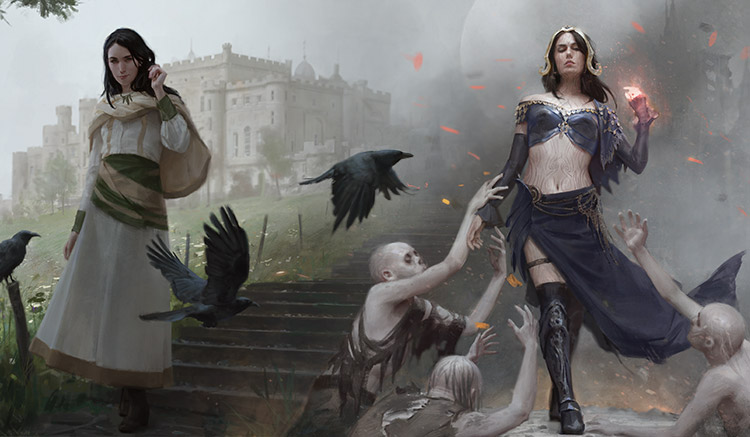
Liliana, Heretical Healer / Liliana, Defiant Necromancer | Art by Karla Ortiz
Here's how legendary creatures and Planeswalkers work. The story team hands off a list of which ones are going to be cards. This usually comes after working with design and development to understand the mechanical needs of the set, the block, and Standard. The design team then does their best to capture the characters in card design form. Those cards then get very aggressively developed and will often change many times trough the iteration.
The important work the design team did with this cycle was setting up the model they wanted each design to follow. The legendary creature would have some ability that was useful unto itself, but helped push toward a condition that would allow the creature to transform into a Planeswalker. The Planeswalker abilities then played into the themes that had been introduced by the legendary creature. First and foremost was to make these cards flavorful and fun to play. Development then spent a lot of time making them powerful as well. These five cards were going to have as bright a spotlight as any cards have ever had. We all worked very hard to make sure they were right. I'm hoping that Sam will have a column one of these days running through the many iterations the cards went through.
Create two brand new mechanics
As I talked about last time, these two mechanics had a bunch of restrictions put on them. To recap: They had to be core-set appropriate—they had to be flavorful and not too complex. They also had to play into the themes of the set—growth and progression. Finally, one needed to be a mechanic that went mostly, if not all, on creatures and one that went mostly, if not all, on instants and sorceries.
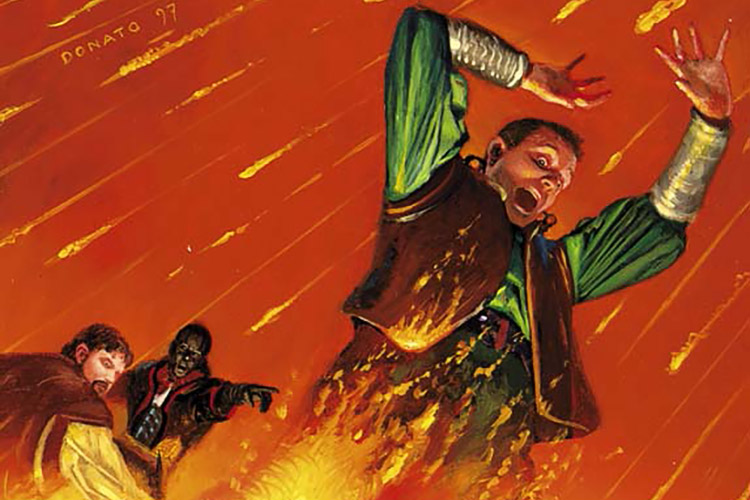
Kindle | Art by Donato Giancola
The team started with the creature mechanic. How can you represent a creature growing? The simplest answer (and remember the goal here was to make a mechanic without too much complexity) was to put one or more +1/+1 counters on the creature. Shawn remembered that there was a mechanic called "veteran" that the Khans of Tarkir team had experimented with while trying to find combat mechanics. The mechanic was very straightforward. The first time the creature dealt combat damage to an opponent, it got some number of +1/+1 counters. The key was figuring out how to get the creature through. It was flavorful, simple, and had plenty of design space. The team put it in and never looked back. Its name would eventually change to "renown."
Spell mastery took a little longer to find. How exactly can spells "level up?" Well, they could get more powerful over time. How would you make that happen? The team looked at an old unnamed mechanic that R&D calls the Kindle mechanic, named for a card from Tempest.
Kindle cards get stronger over time by caring about how many other copies of the card are in your graveyard. To make the new mechanic a little less parasitic (requiring you to play more of that card), the team tried having spells "level up" when you had a certain number of instants and/or sorceries in your graveyard. I'm not sure whether they started with two, but it's where they ended up.
Create a mechanical framework to allow the creative to tell five different stories
This was the next big challenge. The set had a structure that was based not in the mechanics but in the story. In order to make the set feel cohesive, they needed to find ways to mechanically link the story to the cards. They accomplished this in a few ways:
The Planeswalker Cards
We already talked about this one, but obviously this was key in allowing players to get their hands on both the pre- and post-ignited spark characters while also finding a very splashy and mechanical way to represent the spark moment for each character.
Before & After
We wanted to make sure that we got a chance to see each character casting magic on their home world and then on the plane of their first visit. It was important to allow you to see not just the characters in each setting but also to show a progression. The design team decided to do this by making two cycles of spell mastery cards, one at common and one at rare. The common cycle would be smaller effects and show the proto-Planeswalkers (after their spark ignited) casting magic on their home world. The rare cycle would be larger splashier effects and show the Planeswalkers post-spark casting magic on the plane of their first visit.
Related Characters
Another way to show off the stories was to involve other characters. The design team (working closely with the story team) did this by making a cycle of rare legendary creatures, one from the home world of each Planeswalker.
The Planes
Not only was it important to show off the characters, but the ten worlds as well. All the cards were divided so that they all (plausibly) could be from one of the ten worlds. The story and art teams worked hard to use the new cards to showcase elements of the worlds we might not have seen before. Players are always asking us to go back to old worlds so this was an opportunity to provide some fan service for those players.
Miscellaneous
Whenever the story and art people found opportunities to show off other aspect of the stories, they did, so as you look through the set you'll be able to piece together other tidbits about the Planeswalkers. If you haven't been checking out "Uncharted Realms," it's been running the origin stories of each of the five featured characters.
As Jenna talked about a few weeks ago, the way we tell story through sets is changing. And Magic Origins is the first to give a glimpse of the kinds of things we're going to be doing.
Find appropriate reprints
Make a fun core set
I'll list these last two goals together as they are connected. While Magic Origins may be a core set-plus, it's still a core set. And the design team had to work hard to make it everything the players would expect out of a core set. Reprints proved a little trickier than normal because of the desire to not use cards whose art clearly indicated a world other than one of the ten. (There are a few that come from sets based on other worlds, but none with defining qualities in their art that definitively put them there.)
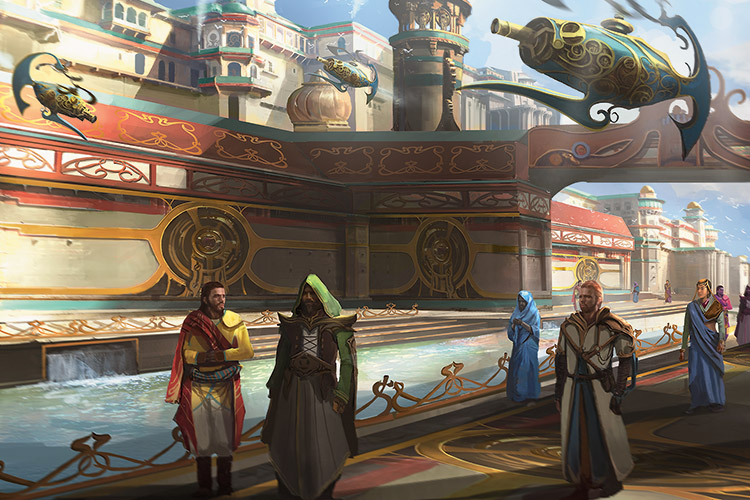
Art by Jung Park
I was impressed that the design team did all the additive things they did to make Magic Origins extra special, while also delivering an excellent core set. Remember, by the way, from my article a few weeks back, that Magic Origins is changing around a few of the evergreen keywords. For those that haven't read it, the short version is menace, prowess, and scry are now in…while intimidate, landwalk, and protection are out. Okay, protection is not completely out—it has one card in the set—but it's no longer evergreen.
One last thing before I go. I owe all of you a preview card. Well, I have a fun one for you.
My preview card comes from Chandra's home world of Kaladesh.
Click here to meet Thopter Spy Network.
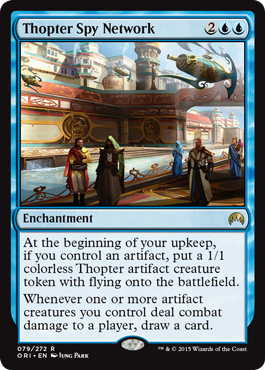
The Origins Story Ends
And that, in two chock-full articles, is the story of the design of Magic Origins. I heartily urge you to go to the Prerelease and play the set, but I also recommend, if you haven't, to read all the origin stories. These five characters are going to be very important, so we want to make sure you're all up to date on who they are, where they came from, and the issues each deal with as those things will prove important in the story to come.
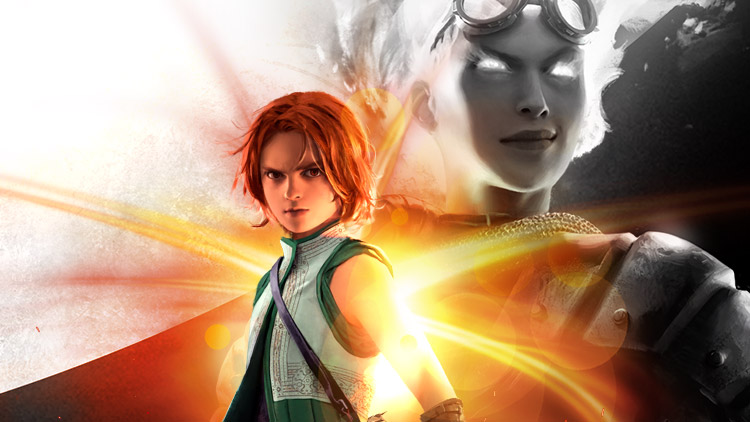
Art by Chase Stone
As always, I'm eager for any feedback either through email or any of my social media (Twitter, Tumblr, Google+, and Instagram).
Join me next week, when I'll review and grade the last one hundred weeks of my column.
Until then, may you check out every piece of art and flavor text in Magic Origins.
"Drive to Work #238—10 Things Every Game Needs—Strategy"
This is the sixth podcast in my ten-part series "10 Things Every Game Needs". Today I talk all about the importance of having surprise in your game.
"Drive to Work #239—Starting in R&D"
I carpool with special guest, Melissa DeTora, and we talk about what it's like to start working in R&D.
- Episode 239 Starting in R&D (15.0 MB)
- Episode 238 10 Things Every Game Needs: Strategy (15.5 MB)
- Episode 237 2010 (18.8MB)
- Episode 236 Leading Teams (14.3 MB)
- Episode 235 Lessons Learned: Dark Ascension (17.8MB)

